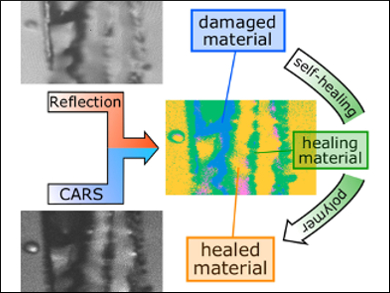Self-healing polymers are a promising class of materials which can automatically repair damage to themselves. The self-healing ability of a new polymer is commonly evaluated by scratching the material and observing its healing behavior with a microscope. Unfortunately, this approach completely neglects molecular aspects of the healing process.
Jürgen Popp, Friedrich Schiller University and Leibniz Institute for Photonic Technology (IPHT), both Jena, Germany, and colleagues have used coherent anti-Stokes Raman scattering (CARS) imaging for the first time to study self-healing polymers. CARS is a non-linear Raman variant which enables the fast recording of large “chemical maps”. These maps show the spatial-temporal distribution of a specific molecular feature, e.g., a C=C bond in a thiol-ene reaction.
The experiments revealed that the molecular crosslinking lags almost three minutes behind the observable material self-healing. Thus, the studied material appears to be healed morphologically, but on the molecular level, the crosslinks responsible for the mechanical stability have not yet formed. The imaging approach could be broadly applicable to other self-healing systems and be useful to fully understand and optimize self-healing properties.
- Do You Get What You See? Understanding Molecular Self-Healing,
Robert Geitner, Fisseha-Bekele Legesse, Natascha Kuhl, Thomas W. Bocklitz, Stefan Zechel, Jürgen Vitz, Martin Hager, Ulrich S. Schubert, Benjamin Dietzek, Michael Schmitt, Jürgen Popp,
Chem. Eur. J. 2018.
https://doi.org/10.1002/chem.201705836


